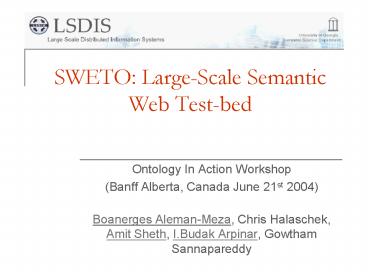SWETO: Large-Scale Semantic Web Test-bed - PowerPoint PPT Presentation
1 / 20
Title:
SWETO: Large-Scale Semantic Web Test-bed
Description:
The emergent Semantic Web community needs a common infrastructure for testing the scalability and quality of new techniques and software which use machine processable ... – PowerPoint PPT presentation
Number of Views:89
Avg rating:3.0/5.0
Title: SWETO: Large-Scale Semantic Web Test-bed
1
SWETO Large-Scale Semantic Web Test-bed
- Ontology In Action Workshop
- (Banff Alberta, Canada June 21st 2004)
- Boanerges Aleman-Meza, Chris Halaschek, Amit
Sheth, I.Budak Arpinar, Gowtham Sannapareddy
2
Outline
- Motivation
- Goals
- Development Framework
- Current Status
- Related Work
- Conclusion Future Work
3
Motivation for SWETO
- Many new techniques and software tools from
emerging Semantic Web community - Need a common infrastructure for testing
- Ontologies are a centerpiece of most approaches
- Need an open and freely available ontology with a
very large knowledge base
4
Motivation for SWETO
- Current ontologies (i.e. TAP KB 3) have breadth
but lack depth - Need for a large scale dataset for testing
algorithms for knowledge discovery (i.e. Semantic
Associations 1)
5
The Big Picture
6
SWETO Goals
- Develop a broad and deep ontology populated with
real facts/data from real world heterogeneous
sources - the instances in the knowledge base should be
highly interconnected - Serve as a test-bed for advanced semantic
applications (i.e. business intelligence,
national security, etc.) - Address the requirements of a research benchmark
for semantic analytics, and the issues of - ontology creation
- semi-automatic extraction
- entity disambiguation
7
Development Framework
- Utilized Semagix Freedom 4 for ontology
creation and metadata extraction - With Freedom, knowledge extractors were created
by specifying regular expressions to extract
entities from various data sources - Open and trusted Web sources
- (semi-) structured sources allow high scalability
in extraction and crawling
8
Development Framework
- Data sources
- Selected sources which were highly reliable Web
sites that provide entities in a - semistructured format
- unstructured data with parse-able structures
(e.g.,html pages with tables) - dynamic web sites with database back-ends
- Considered the types and quantity of
implicit/explicit relationships - preferred sources in which instances were
interconnected - Considered sources whose entities would have rich
metadata - Public and open sources were preferred
- due to the desire to make SWETO openly available
9
Development Framework
- As the sources were scraped by the extractors,
entities are extracted and stored in appropriate
classes in an ontology - Due to heterogeneous data sources, entity
disambiguation is a crucial step - Freedoms disambiguation techniques automatically
resolved entity ambiguities in 99 of the cases,
leaving less than 1 for human disambiguation
(about 200 cases)
10
Development Framework
- Utilize Freedoms API for exporting both the
ontology and its instances in either RDF 5 or
OWL 2 syntax - Extractors are scheduled to rerun for keeping the
ontology updated
11
(Semagix) Application Architecture
12
Current Status
- Current population includes over 800,000 entities
and over 1,500,000 explicit relationships among
them - Continue to populate the ontology with diverse
sources thereby extending it in multiple domains
13
Current Status Classes
Subset of classes in the ontology Instances
Cities, countries, and states 2,902
Airports 1,515
Companies, and banks 30,948
Terrorist attacks, and organizations 1,511
Persons and researchers 307,417
Scientific publications 463,270
Journals, conferences, and books 4,256
TOTAL (as of May 2004) 811,819
14
Current Status Relationships
Subset of relationships Explicit relations
located in 30,809
responsible for (event) 1,425
Listed author in 1,045,719
(paper) published in 467,367
15
Current Status Disambiguation
Disambiguation type Times used
Automatic (Freedom) 248,151
Manual 210
Unresolved (Removed) 591
16
Browsing of the Schema
17
Related Work
- TAP KB 3 is fairly broad but not very deep
knowledge base annotated in RDF
18
Conclusions Future Work
- Using Semagix Freedom, we have created a very
broad and deep Semantic Web Evaluation Ontology
(SWETO) - Contains over 800,000 entities and over 1,500,000
explicit relationships among them - Aim to continue the population of SWETO by
further extraction of data - Also plan to further investigate the use of
semantic similarity for entity disambiguation
19
SWETO Project Homepage
- http//lsdis.cs.uga.edu/Projects/Semdis/SWETO/
- Project description, papers, presentations
20
References
- 1 K. Anyanwu, and A. Sheth. r-Queries
Enabling Querying for Semantic Associations on
the Semantic Web. Twelfth International World
Wide Web Conference, Budapest, Hungary. May
20-24, 2003 pp. 690-699 - 2 S. Bechhofer, F. Harmelen, J. Hendler, I.
Horrocks, D. McGuinness, P. Patel-Schneider, et
al. (2003). OWL Web Ontology Language
Reference. W3C Proposed Recommendation, from
http//www.w3.org/TR/owl-ref/ - 3 R. Guha and R. McCool. Tap A Semantic Web
Test-Bed. Journal of Web Semantics, 1(1), Dec.
2003, pp. 81-87 - 4 B. Hammond, A. Sheth, K. Kochut. Semantic
Enhancement Engine A Modular Docu-ment
Enhancement Platform for Semantic Applications
over Heterogeneous Content in Real World Semantic
Web Applications. V. Kashyap L. Shklar, Eds.,
IOS Press, 2002 - 5 O. Lassila, R. Swick. Resource Description
Framework (RDF) Model and Syntax Specification.
W3C Recommendation, from http//www.w3.org/TR/REC-
rdf-syntax/































